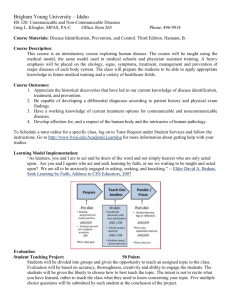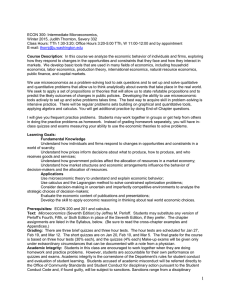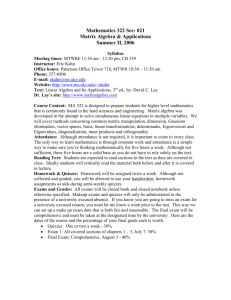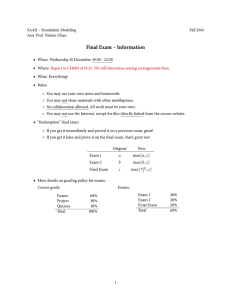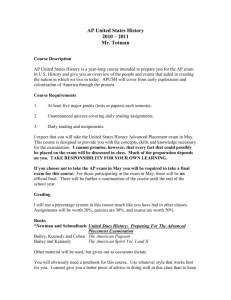BOSTON COLLEGE Department of Economics
advertisement
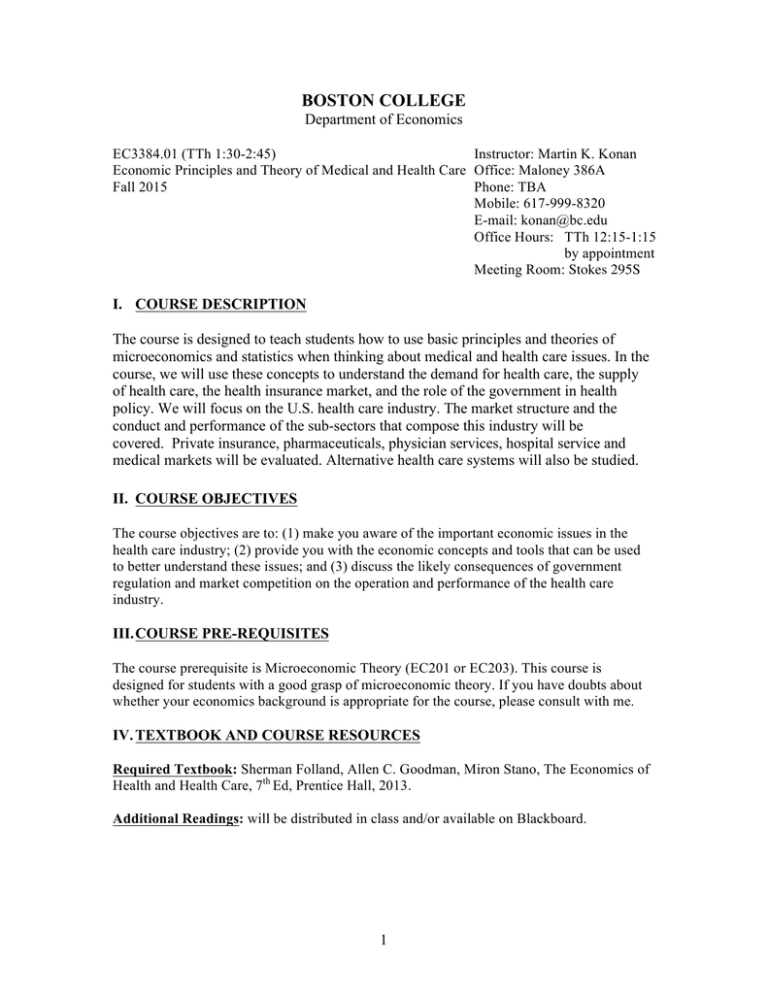
BOSTON COLLEGE Department of Economics EC3384.01 (TTh 1:30-2:45) Instructor: Martin K. Konan Economic Principles and Theory of Medical and Health Care Office: Maloney 386A Fall 2015 Phone: TBA Mobile: 617-999-8320 E-mail: konan@bc.edu Office Hours: TTh 12:15-1:15 by appointment Meeting Room: Stokes 295S I. COURSE DESCRIPTION The course is designed to teach students how to use basic principles and theories of microeconomics and statistics when thinking about medical and health care issues. In the course, we will use these concepts to understand the demand for health care, the supply of health care, the health insurance market, and the role of the government in health policy. We will focus on the U.S. health care industry. The market structure and the conduct and performance of the sub-sectors that compose this industry will be covered. Private insurance, pharmaceuticals, physician services, hospital service and medical markets will be evaluated. Alternative health care systems will also be studied. II. COURSE OBJECTIVES The course objectives are to: (1) make you aware of the important economic issues in the health care industry; (2) provide you with the economic concepts and tools that can be used to better understand these issues; and (3) discuss the likely consequences of government regulation and market competition on the operation and performance of the health care industry. III. COURSE PRE-REQUISITES The course prerequisite is Microeconomic Theory (EC201 or EC203). This course is designed for students with a good grasp of microeconomic theory. If you have doubts about whether your economics background is appropriate for the course, please consult with me. IV. TEXTBOOK AND COURSE RESOURCES Required Textbook: Sherman Folland, Allen C. Goodman, Miron Stano, The Economics of Health and Health Care, 7th Ed, Prentice Hall, 2013. Additional Readings: will be distributed in class and/or available on Blackboard. 1 V. EVALUATION OF STUDENT PERFORMANCE Course requirements will be weighted as follows in the determination of final grades: Events Approximate dates QUIZ # 1 September 22, (Tuesday) MIDTERM EXAM October 20, (Tuesday) QUIZ # 2 November 10, (Tuesday) FINAL EXAM TBA RESEARCH PAPER December 8, (Tuesday) HOMEWORK ASSIGNMENTS CLASS ATTENDANCE AND PARTICIPATION Grade Weight 10% 25% 10% 30% 10% 10% 5% These dates are subject to change. These exercises will be cumulative, though emphasis will be placed on the more recent material covered. Regardless of your aggregate numeric grade, a minimally satisfactory score is required on each exam. Note: All exams and quizzes will be held in the regular classroom. QUIZZES: There will be two in-class quizzes during the term. The quizzes will be approximately 30 minutes in length. The primary purpose of the quizzes is to give you a bit of practice prior to the examinations, and to help reduce some of the examination pressure. But don't take them lightly. EXAMS: There will be two in-class exams during the term. The midterm exam will be approximately 75-90 minutes in length. The final exam (not comprehensive) will be approximately 120 minutes. These exams will test your understanding of the core material. RESEARCH PAPER Students must complete a 10-page research paper on a health economics topic of their choice. The paper must be an original contribution to the field. Details on the requirements of the paper will be distributed in class. HOME ASSIGNMENTS 10% of your grade will be assigned to home assignments. Home assignments may be an analysis of financial or economic news, a written summary of a section or chapter of an assigned reading, a problem to solve or a question to discuss in class. Home assignments must be typed and are due in the following class automatically, unless mentioned otherwise. Missing class does not waive or extend the deadline for submitting an assignment. CLASS ATTENDANCE AND PARTICIPATION Since student attendance and participation in class discussions are an important part of the course, 5% of your grade will be assigned to student attendance and participation. 2 VI. GRADES Credit will be determined by assigning a numerical value to each category, corresponding to 100%. Final grades will be calculated by multiplying the relative weights by the achievement earned for each category. Letter grades will be assigned as follows: • • • • • • • • • • • • A: At least 94 percent of the possible points in the class A-: 90 to 93 percent of the possible points in the class B+: 87 to 89 percent of the possible points in the class B: 83 to 86 percent of the possible points in the class B-: 80 to 82 percent of the possible points in the class C+: 77 to 79 percent of the possible points in the class C: 73 to 76 percent of the possible points in the class C-: 70 to 72 percent of the possible points in the class D+: 67 to 69 percent of the possible points in the class D: 63 to 66 percent of the possible points in the class D-: 60 to 62 percent of the possible points in the class F: Fewer than 60 percent of the possible points in the class I reserve the right to lower this scale at any time--for example, I may determine that 93 points should be an A. I will not raise it. VII. COURSE ORGANIZATION AND EXPECTATIONS Course Structure: Class sessions will consist primarily of lectures and review of problems. All new material will be presented to you either during the lectures or in the reading assignments. You are responsible for all such material. Attendance is mandatory. Each student is responsible for any announcement made in class. Quizzes and Exams: There will be two in-class quizzes, one midterm exam and a final exam. You are allowed two 8.5x11 sheets of notes on the quizzes, and four 8.5x11 sheets of notes on both exams. You may write anything on both sides of the sheets. The quizzes and exams will cover materials covered in class as well as assigned in readings and homework problems. Policy on Missed Exams: Any missed exam will receive a grade of zero unless a written excuse is submitted from the Office of Class Deans. In all but the most extreme emergencies, these excuses must be submitted in advance of the missed exam Problem Sets: The best way to learn economics and finance is by solving problems. There will be weekly problem sets throughout the course. Although these are not to be collected and graded, you are expected to do these in a timely manner, as they are integral to the course design. I urge you to do most problems. They are designed to help you study for the exams. It is therefore in your best interest to work on them thoroughly. Some class time may be devoted to the review of problems. 3 We will be covering a fair amount of material in a limited amount of time. Also, the development of the material will be cumulative -- it will build upon itself -- so don't let things get behind. Feel free to stop me at any point to ensure that you understand before moving on. Ask questions and visit in my office during my office hours (TTh 12:15PM-1:15PM). You can also make an appointment for other days or time. I expect each of you to drop-in before too long (or too late). Before class, you should review previous material and skim the text to get an idea of the material to be covered in class. During class you should take good notes, ask questions if there is any point, which is not clear. You should encourage and engage in discussion when it seems appropriate. After class, you should review your notes, read the appropriate text material, and prepare a list of anything you need clarified. So class attendance is extremely important and active participation in class is strongly encouraged. Class Participation: Class interaction is very important for all of us to gain the most from the course. You can expect both the quality and frequency of your contributions to be considered in your overall grade. Attendance and Norms of Civility: Regular class attendance is strongly recommended. If you must miss a class, please telephone or e-mail me in advance. Please note that I will be tracking participation performance in each class. Repeated absences can significantly impact your final grade for the course. In order to maintain a classroom environment, which is pleasant and conducive to learning, certain modes of conduct will be expected to be followed by all students in this class. 1. Tardiness is considerably distracting to your classmates; therefore all effort should be made to arrive on time. 2. Limited amounts or liquid refreshments are all right, but eating a meal at your desk is not acceptable conduct. It is inconsiderate and distracting. 3. Cell phones, beepers, pagers, or any type of signaling device are not permitted in class. 4. We do realize that your classes are lengthy and there is limited space in the rest rooms to be used during breaks, but frequent coming and going during the class is discouraged. 5. Do not leave trash behind in the classroom when you leave nor write on furniture. 6. Refrain from prematurely closing books and notebooks before class ends. This is impolite and distracting to people around you. 7. It is expected that your conduct in class show respect to others in several ways: a. No use of profanity b. Interrupting others is not acceptable conduct c. Respect of others can be shown by listening to their comments and answers, as you would expect them to pay attention to your remarks. VIII. ACADEMIC INTEGRITY The academic enterprise at Boston College assumes academic integrity, which in this course means that all your work on your exams and your paper is your own, and that you appropriately reference the work of others in your paper. Always err on the side of citation! Violations of academic integrity will be reported to your class dean and then reviewed by the College of Arts and Sciences Academic Integrity Committee. Consequences can be very serious. I urge you to review university policy and procedures at: http://www.bc.edu/integrity. 4 If you have any questions, please consult with me. IX. ACCOMMODATIONS FOR DISABILITIES If you have a disability and will be requesting accommodations for this course, please register with either Kathy Duggan (Kathleen.duggan@bc.edu) Associate Director, Academic Support Services, the Connors Family Learning Center (learning disabilities and ADHD) or Paulette Durrett (paulette.durrett@bc.edu), Assistant Dean for Students with Disabilities (all other disabilities). Advance notice and appropriate documentation are required for accommodations. 5 X. FALL SEMESTER 2015 ACADEMIC CALENDAR August 31 Monday Classes begin September 7 Monday Labor Day—No classes September 9 Wednesday Last date for graduate students to drop/add in UIS September 9 Wednesday Last date for undergraduate students to drop/add or to declare a course pass/fail in UIS September 9 Wednesday Last date for all students who plan to graduate in December 2015 to verify their diploma names online September 10 Thursday Mass of the Holy Spirit at noon; classes canceled from noon to 1:15 p.m. September 18 Friday Friday evening football at 8:00 p.m. Classes, labs, and discussion sections on all BC’s campuses that would ordinarily start at 4:00 p.m. or earlier and extend past 5:00 p.m. may be held at the instructor’s discretion. September 25 to September 27 Friday to Sunday Parents' Weekend October 1 Thursday Last date for undergraduates only to drop a course or to declare a course pass/fail in the Associate Deans’ office October 12 Monday Columbus Day—No classes October 22 Thursday Undergraduate Academic Advising period begins for spring registration November 12 Thursday Graduate/CASU registers November 13 Friday Undergraduate registration period for spring 2016 begins November 25 to November 27 Wednesday to Friday Thanksgiving Holidays November 30 Monday Last date for official withdrawal from a course or from the university December 1 Tuesday Last date for master’s and doctoral candidates to submit signed and approved copies of theses and dissertations for December 2015 graduation December 10 to December 11 Thursday to Friday Study days—No classes for undergraduate day students only December 12 to December 19 Saturday to Saturday Term examinations 6 XI. READING SCHEDULE PART I: Basic Economics Tools Chapter 1: Introduction Chapter 2: Microeconomic Tools for Health Economics Chapter 3: Statistical Tools for Health Economics Chapter 4: Economic Efficiency and Cost-Benefit Analysis PART II: Supply and Demand Chapter 5: Production of Health Chapter 6: The Production, Cost, and Technology of Health Care Chapter 7: Demand for Health Capital Chapter 8: Demand and Supply of Health Insurance Chapter 9: Consumer Choice and Demand PART III: Information and Insurance Markets Chapter 10: Asymmetric Information and Agency Chapter 11: The Organization of Health Insurance Markets Chapter 12: Managed Care (optional) Chapter 13: Nonprofit Firms (optional) PART IV: Key Players in the Health Care Sector Chapter 14: Hospitals and Long-Term Care (optional) Chapter 15: The Physician’s Practice (optional) Chapter 16: Health Care Labor Markets and Professional Training Chapter 17: The Pharmaceutical Industry PART V: Social Insurance Chapter 18: Equity, Efficiency, and Need (optional) Chapter 19: Government Intervention in Health Care Markets Chapter 20: Government Regulation: Principal Regulatory Mechanisms Chapter 21: Social Insurance (optional) Chapter 22: Comparative Health Care Systems (optional) Chapter 23: Health System Reform PART VI: Special Topics Chapter 24: The Health Economics of Bads (optional) Chapter 25: Epidemiology and Economics: HIV/AIDS in Africa (optional) 7
